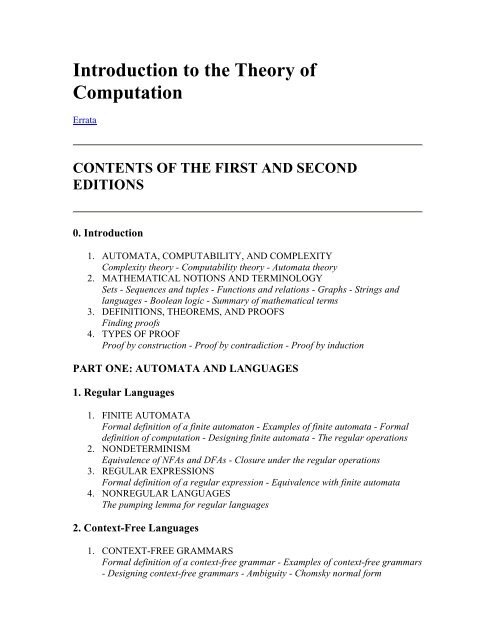Introduction to the Theory of Computation
Introduction to the Theory of Computation
Introduction to the Theory of Computation
You also want an ePaper? Increase the reach of your titles
YUMPU automatically turns print PDFs into web optimized ePapers that Google loves.
<strong>Introduction</strong> <strong>to</strong> <strong>the</strong> <strong>Theory</strong> <strong>of</strong><br />
<strong>Computation</strong><br />
Errata<br />
CONTENTS OF THE FIRST AND SECOND<br />
EDITIONS<br />
0. <strong>Introduction</strong><br />
1. AUTOMATA, COMPUTABILITY, AND COMPLEXITY<br />
Complexity <strong>the</strong>ory - Computability <strong>the</strong>ory - Au<strong>to</strong>mata <strong>the</strong>ory<br />
2. MATHEMATICAL NOTIONS AND TERMINOLOGY<br />
Sets - Sequences and tuples - Functions and relations - Graphs - Strings and<br />
languages - Boolean logic - Summary <strong>of</strong> ma<strong>the</strong>matical terms<br />
3. DEFINITIONS, THEOREMS, AND PROOFS<br />
Finding pro<strong>of</strong>s<br />
4. TYPES OF PROOF<br />
Pro<strong>of</strong> by construction - Pro<strong>of</strong> by contradiction - Pro<strong>of</strong> by induction<br />
PART ONE: AUTOMATA AND LANGUAGES<br />
1. Regular Languages<br />
1. FINITE AUTOMATA<br />
Formal definition <strong>of</strong> a finite au<strong>to</strong>ma<strong>to</strong>n - Examples <strong>of</strong> finite au<strong>to</strong>mata - Formal<br />
definition <strong>of</strong> computation - Designing finite au<strong>to</strong>mata - The regular operations<br />
2. NONDETERMINISM<br />
Equivalence <strong>of</strong> NFAs and DFAs - Closure under <strong>the</strong> regular operations<br />
3. REGULAR EXPRESSIONS<br />
Formal definition <strong>of</strong> a regular expression - Equivalence with finite au<strong>to</strong>mata<br />
4. NONREGULAR LANGUAGES<br />
The pumping lemma for regular languages<br />
2. Context-Free Languages<br />
1. CONTEXT-FREE GRAMMARS<br />
Formal definition <strong>of</strong> a context-free grammar - Examples <strong>of</strong> context-free grammars<br />
- Designing context-free grammars - Ambiguity - Chomsky normal form
2. PUSHDOWN AUTOMATA<br />
Formal definition <strong>of</strong> a pushdown au<strong>to</strong>ma<strong>to</strong>n - Examples <strong>of</strong> pushdown au<strong>to</strong>mata -<br />
Equivalence with context-free grammars<br />
3. NON-CONTEXT-FREE LANGUAGES<br />
The pumping lemma for context-free languages<br />
PART TWO: COMPUTABILITY THEORY<br />
3. The Church-Turing Thesis<br />
1. TURING MACHINES<br />
Formal definition <strong>of</strong> a Turing machine - Examples <strong>of</strong> Turing machines<br />
2. VARIANTS OF TURING MACHINES<br />
Multitape Turing machines - Nondeterministic Turing machines - Enumera<strong>to</strong>rs -<br />
Equivalence with o<strong>the</strong>r models<br />
3. THE DEFINITION OF ALGORITHM<br />
Hilbert's problems - Terminology for describing Turing machines<br />
4. Decidability<br />
1. DECIDABLE LANGUAGES<br />
2. THE HALTING PROBLEM<br />
The diagonalization method - The halting problem is undecidable - A Turingunacceptable<br />
language<br />
5. Reducibility<br />
1. UNDECIDABLE PROBLEMS FROM \\ LANGUAGE THEORY<br />
Reductions via computation his<strong>to</strong>ries<br />
2. A SIMPLE UNDECIDABLE PROBLEM<br />
3. MAPPING REDUCIBILITY<br />
Computable functions - Formal definition <strong>of</strong> mapping reducibility<br />
6. Advanced Topics in Computability <strong>Theory</strong><br />
1. THE RECURSION THEOREM<br />
Self-reference - Terminology for <strong>the</strong> recursion <strong>the</strong>orem - Applications<br />
2. DECIDABILITY OF LOGICAL THEORIES<br />
A decidable <strong>the</strong>ory - An undecidable <strong>the</strong>ory<br />
3. TURING REDUCIBILITY<br />
4. A DEFINITION OF INFORMATION<br />
Minimal length descriptions - Optimality <strong>of</strong> <strong>the</strong> definition - Incompressible strings<br />
and randomness<br />
PART THREE: COMPLEXITY THEORY
7. Time Complexity<br />
1. MEASURING COMPLEXITY<br />
Big-O and small-o notation - Analyzing algorithms - Complexity relationships<br />
among models<br />
2. THE CLASS P<br />
Polynomial time - Examples <strong>of</strong> problems in P<br />
3. THE CLASS NP<br />
Examples <strong>of</strong> problems in NP - The P versus NP question<br />
4. NP-COMPLETENESS<br />
Polynomial time reducibility - Definition <strong>of</strong> NP-completeness - The Cook-Levin<br />
Theorem<br />
5. EXAMPLES OF NP-COMPLETE PROBLEMS<br />
The vertex cover problem - The Hamil<strong>to</strong>nian path problem - The subset sum<br />
problem<br />
8. Space Complexity<br />
1. SAVITCH'S THEOREM<br />
2. THE CLASS PSPACE<br />
3. PSPACE-COMPLETENESS<br />
The TQBF problem - Winning strategies for games - Generalized geography<br />
4. THE CLASSES L AND NL<br />
5. NL-COMPLETENESS<br />
Searching in graphs<br />
6. NL EQUALS CONL<br />
9. Intractability<br />
1. HIERARCHY THEOREMS<br />
Exponential space completeness<br />
2. RELATIVIZATION<br />
Limits <strong>of</strong> <strong>the</strong> diagonalization method<br />
3. CIRCUIT COMPLEXITY<br />
10. Advanced Topics in Complexity <strong>Theory</strong><br />
1. APPROXIMATION ALGORITHMS<br />
2. PROBABILISTIC ALGORITHMS<br />
The class BPP - Primality - Read-once branching programs<br />
3. ALTERNATION<br />
Alternating time and space - The Polynomial time hierarchy<br />
4. INTERACTIVE PROOF SYSTEMS<br />
Graph nonisomorphism - Definition <strong>of</strong> <strong>the</strong> model - IP = PSPACE<br />
5. PARALLEL COMPUTATION<br />
Uniform Boolean circuits - The class NC - P-completeness
6. CRYPTOGRAPHY<br />
Secret keys - Public-key cryp<strong>to</strong>systems - One-way functions - Trapdoor functions<br />
Exercises and Problems<br />
Selected Bibliography<br />
Index

















